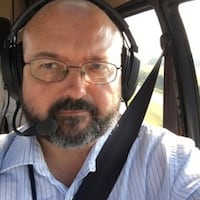The idea animating Kent Tiffany, Unmanned Solutions Technology’s chief operating officer, is simple: Build the right UAVs, and customers will come.
RELATED: Ohio, Dayton take center stage at drone event
“I’m a little bit in a Field-of-Dreams mode right now,” he said in a interview. “I’m trying to build this capability and get people to recognize how important it is.”
Sinclair already has a “maintenance trainer” version of the company’s Pelican II vehicle, said Andrew Shepherd, director of unmanned aerial systems for Sinclair as well as managing editor of the Journal of Unmanned Aerial Systems.
Shepherd said the college has not yet started flight operations with the Pelican II yet.
“However, we have been present for recent flights conducted by UST (Unmanned Solutions Technology) and have been impressed by the system’s performance,” he said. “Sinclair selected UST because they offer professional grade ground support equipment and (unmanned aerial systems) with capabilities rivaling or surpassing many other national or international competitors.”
RELATED: Dayton film producer adds a UAV.
Sinclair will use the Pelican II — a light model that can be landed on water — to work with NASA Glenn on collecting samples over Lake Erie, a continuation of work the college has pursued for months. The flyer will be used for educational purposes, as well.
Where possible, Sinclair will partner with local companies in the drones arena, he added. The college is also purchasing a heavily modified van from the company equipped with a mobile control station for the Pelican II. A key part of the company’s overall technology is its mobile ground control station with auto pilot capability.
Tiffany is a former military aviator who said he was the Air Force’s first test pilot for UAVs, stationed at Edwards Air Force Base in California from 1998 to 2004. He retired as a lieutenant colonel in 2010, coming to the Dayton area for a consulting gig before starting this business.
TAKING FLIGHT:Dayton businesses take to the skies with UAVs
Tiffany said he and his crew are working on keeping small UAVs up longer. They see deployment possibilities for utility companies — inspecting solar panels, power lines,wind turbines and more — law enforcers, emergency first responders and others. The vehicles can cover large areas in a short time, going where it’s dangerous or inconvenient for people to go.
Estimates of the size of the commercial UAV market in coming years vary widely. Keying off a 2016 Goldman Sachs report, the British news magazine The Economist reported recently that $100 billion is “likely to be spent on both military and civilian drones between 2016 and 2020, (with) the commercial segment (being) the fastest-growing,”
RELATED: Aerial video: Wright factory site targeted by aviation alliance
Unmanned Solutions Technology has flown UAVs for more than an hour, a solid mark for the kinds of drones the company flies. Extending flight duration remains a key goal — and that takes power.
"There's a company in town here named Xerion (Advanced Battery Corp.) that has revolutionary batteries," Tiffany said. "I'm looking at possibly test-flying some of their batteries in our vehicle — and that would go very well with this technology … if we could get their batteries into this bird, I think that would that would actually double the duration."
Assembly of Pelican IIs happens in the company’s small offices off South Metro Parkway.
“Right now, we’re able to make about one a month,” Tiffany said. “Sinclair has bought the first production aircraft, and that’s what we’re delivering.”
About the Author

